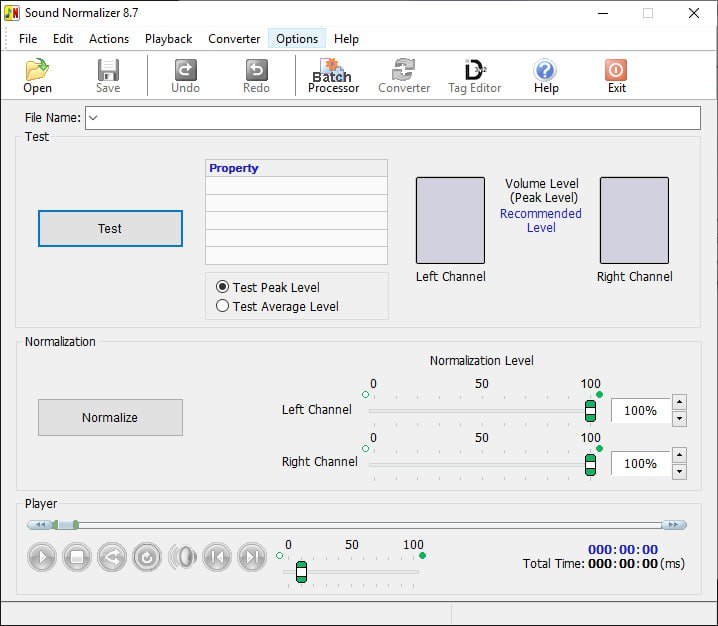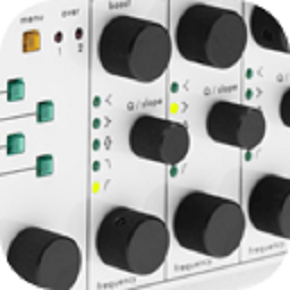Download Sound Normalizer 8 full version program free setup for Windows. The Mp3 / Wav / FLAC / Ogg / APE Normalizer – Sound Normalizer reduce, improves, regains a volume and a file size without losing ID3, FLAC, Ogg tags of Mp3, Ogg, FLAC, APE and Wav (PCM 8, 16, 24, 32 bits, DSP, GSM, IMA ADPCM, MS ADPCM, AC3, MP3, MP2, OGG, A-LAW, u-LAW) files.
Sound Normalizer Overview
Sound Normalizer is a software application designed to optimize and standardize the audio levels of digital audio files. It serves a crucial role in the world of audio processing, as it helps to ensure consistent and balanced sound quality across different audio tracks. Whether you’re a music enthusiast, a podcaster, or a professional audio engineer, Sound Normalizer can be a valuable tool in your audio editing toolkit. One of the primary functions of Sound Normalizer is to adjust the volume levels of audio files to a consistent level, which is particularly important when dealing with a collection of songs or audio recordings with varying volume levels. This normalization process helps prevent sudden volume jumps or dips when listening to a playlist or a series of audio tracks, creating a more enjoyable and comfortable listening experience. Sound Normalizer offers various normalization options and settings, allowing users to customize the degree of volume adjustment to suit their specific needs. Users can choose to normalize to a target peak level, ensuring that the loudest parts of the audio reach a specified level without causing distortion or clipping. Alternatively, they can normalize to a more general RMS (Root Mean Square) level, which considers the overall energy of the audio. You may also like KiloHearts Toolbox Ultimate 2.1.1

Additionally, Sound Normalizer can perform batch processing, enabling users to normalize multiple audio files simultaneously, saving time and effort when working with large audio libraries. It supports a wide range of audio file formats, including popular formats like MP3, WAV, FLAC, and more. Another notable feature of Sound Normalizer is its ability to analyze and display the waveform and volume statistics of audio files, providing users with valuable information about the characteristics of their audio tracks. This visual feedback can help users make informed decisions when adjusting volume levels and deciding on the appropriate normalization settings. In conclusion, Sound Normalizer is a versatile and essential tool for anyone involved in audio editing and production. Whether you’re preparing music playlists, editing podcasts, or mastering audio for professional projects, Sound Normalizer can help you achieve consistent and balanced sound quality, enhancing the overall listening experience for your audience. Its user-friendly interface and powerful normalization capabilities make it a valuable asset in the world of audio processing.
Features
- Volume Normalization: Sound Normalizer can adjust the volume levels of audio files to a consistent and balanced level, preventing abrupt volume changes during playback.
- Batch Processing: It supports batch processing, allowing users to normalize multiple audio files simultaneously, saving time and effort.
- Multi-Format Support: Sound Normalizer can work with various audio formats, including MP3, WAV, FLAC, AAC, OGG, and more.
- Peak Normalization: Users can normalize audio to a specified peak level, ensuring that the loudest parts of the audio reach a particular amplitude without distortion.
- RMS Normalization: This option normalizes audio to a Root Mean Square (RMS) level, which considers the overall energy of the audio.
- Custom Target Levels: Users can set their desired target levels for normalization to meet specific requirements.
- Visual Waveform Display: Sound Normalizer provides a visual representation of the audio waveform, allowing users to see and analyze the audio’s characteristics.
- Volume Statistics: It displays volume statistics, including minimum and maximum levels, enabling users to make informed decisions when normalizing.
- Automatic Volume Analysis: The software can analyze audio files and suggest optimal normalization settings based on their characteristics.
- Undo/Redo: Users can easily undo and redo normalization operations to fine-tune adjustments.
- Preserve Original Files: Sound Normalizer can create normalized copies of audio files, leaving the original files untouched.
- Apply Gain: Users can apply gain adjustments to audio files, increasing or decreasing their volume levels.
- Noise Reduction: Some versions of Sound Normalizer offer noise reduction tools to clean up audio recordings.
- Trimming: It allows users to trim audio files, removing unwanted sections at the beginning or end.
- Fade In/Out: Users can add fade-in and fade-out effects to audio files for smooth transitions.
- Tag Editing: Sound Normalizer may include tag editing capabilities for managing metadata like artist, title, album, and genre.
- Format Conversion: Some versions can convert audio files from one format to another.
- Equalization: It may offer basic equalization options to adjust the frequency balance of audio.
- Peak Level Detection: The software can detect and highlight peak levels in the audio waveform.
- Bitrate Adjustment: Users can change the bitrate of audio files during the normalization process.
- Multi-Platform Compatibility: Sound Normalizer is often available for Windows, macOS, and sometimes Linux.
- User-Friendly Interface: It typically features an intuitive and easy-to-use graphical user interface.
- Online Help and Documentation: Users can access online guides and documentation for assistance.
- Preview Functionality: Some versions allow users to preview audio changes before applying them.
- Advanced Settings: Users can fine-tune various parameters for normalization, including attack and release times.
- Automatic Updates: The software may offer automatic update notifications and downloads.
- Crossfading: It can enable crossfading between tracks for smoother transitions in playlists.
- Speed and Performance: Sound Normalizer is optimized for efficient processing and low resource usage.
- Custom Output Folder: Users can specify where to save the normalized audio files.
- Multi-Language Support: It often provides support for multiple languages to cater to a global user base.
- Drag-and-Drop Functionality: Users can easily drag and drop audio files into the software for processing.
- Folder Monitoring: Some versions can monitor specific folders for new audio files to normalize automatically.
- Multi-Core CPU Support: It can leverage the processing power of multi-core CPUs for faster batch processing.
- File Information Display: Users can view detailed information about audio files, including codec, sample rate, and duration.
- Quality Settings: Users can adjust the quality of output files to balance size and audio fidelity.
- Normalization Log: It may log the details of the normalization process for reference.
- Auto Shutdown: Users can set the software to shut down the computer automatically after processing is complete.
- Customizable Hotkeys: Keyboard shortcuts can be customized for quick access to various functions.
- File Renaming: Some versions offer options to rename files based on tags or custom patterns.
- Export Reports: Users can generate reports detailing the normalization process for reference or documentation purposes.
Technical Details
- Software Name: Sound Normalizer for Windows
- Software File Name: Sound-Normalizer-8.7.rar
- Software Version: 8.7
- File Size: 7.91 MB
- Developers: kanssoftware
- File Password: 123
- Language: Multilingual
- Working Mode: Offline (You donÆt need an internet connection to use it after installing)
System Requirements
- Operating System: Win 7, 8, 10, 11
- Free Hard Disk Space:
- Installed Memory: 1 GB
- Processor: Intel Dual Core processor or later
- Minimum Screen Resolution: 800 x 600
What is the latest version of Sound Normalizer?
The developers consistently update the project. You can view the most recent software update on their official website.
Is it worth it to install and use Software Sound Normalizer?
Whether an app is worth using or not depends on several factors, such as its functionality, features, ease of use, reliability, and value for money.
To determine if an app is worth using, you should consider the following:
- Functionality and features: Does the app provide the features and functionality you need? Does it offer any additional features that you would find useful?
- Ease of use: Is the app user-friendly and easy to navigate? Can you easily find the features you need without getting lost in the interface?
- Reliability and performance: Does the app work reliably and consistently? Does it crash or freeze frequently? Does it run smoothly and efficiently?
- Reviews and ratings: Check out reviews and ratings from other users to see what their experiences have been like with the app.
Based on these factors, you can decide if an app is worth using or not. If the app meets your needs, is user-friendly, works reliably, and offers good value for money and time, then it may be worth using.
Is Sound Normalizer Safe?
Sound Normalizer is widely used on Windows operating systems. In terms of safety, it is generally considered to be a safe and reliable software program. However, it’s important to download it from a reputable source, such as the official website or a trusted download site, to ensure that you are getting a genuine version of the software. There have been instances where attackers have used fake or modified versions of software to distribute malware, so it’s essential to be vigilant and cautious when downloading and installing the software. Overall, this software can be considered a safe and useful tool as long as it is used responsibly and obtained from a reputable source.
How to install software from the WinRAR file?
To install an application that is in a WinRAR archive, follow these steps:
- Extract the contents of the WinRAR archive to a folder on your computer. To do this, right-click on the archive and select ”Extract Here” or ”Extract to [folder name]”.”
- Once the contents have been extracted, navigate to the folder where the files were extracted.
- Look for an executable file with a .exeextension. This file is typically the installer for the application.
- Double-click on the executable file to start the installation process. Follow the prompts to complete the installation.
- After the installation is complete, you can launch the application from the Start menu or by double-clicking on the desktop shortcut, if one was created during the installation.
If you encounter any issues during the installation process, such as missing files or compatibility issues, refer to the documentation or support resources for the application for assistance.
Can x86 run on x64?
Yes, x86 programs can run on an x64 system. Most modern x64 systems come with a feature called Windows-on-Windows 64-bit (WoW64), which allows 32-bit (x86) applications to run on 64-bit (x64) versions of Windows.
When you run an x86 program on an x64 system, WoW64 translates the program’s instructions into the appropriate format for the x64 system. This allows the x86 program to run without any issues on the x64 system.
However, it’s important to note that running x86 programs on an x64 system may not be as efficient as running native x64 programs. This is because WoW64 needs to do additional work to translate the program’s instructions, which can result in slower performance. Additionally, some x86 programs may not work properly on an x64 system due to compatibility issues.
What is the verdict?
This app is well-designed and easy to use, with a range of useful features. It performs well and is compatible with most devices. However, may be some room for improvement in terms of security and privacy. Overall, it’s a good choice for those looking for a reliable and functional app.
Download Sound Normalizer 8 Latest Version Free
Click on the button given below to download Sound Normalizer free setup. It is a complete offline setup for Windows and has excellent compatibility with x86 and x64 architectures.



